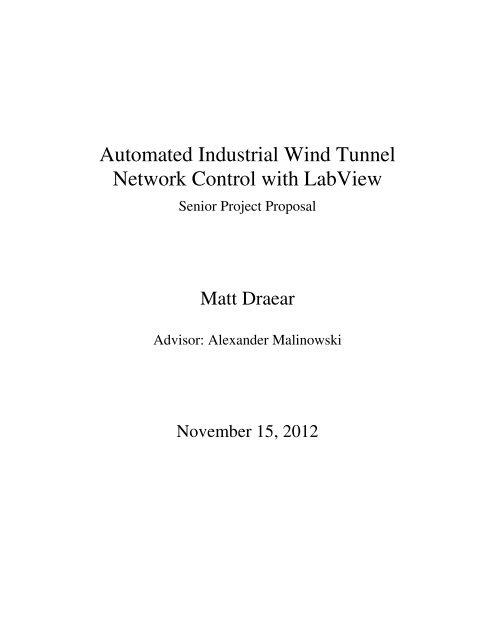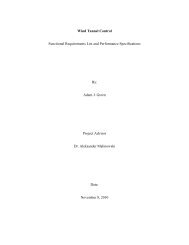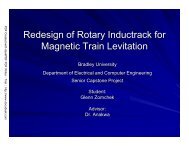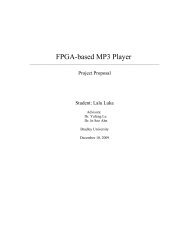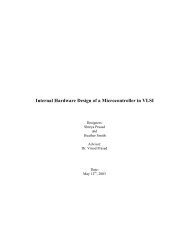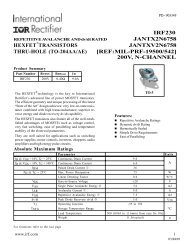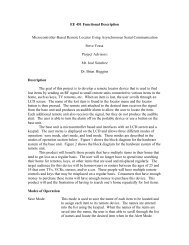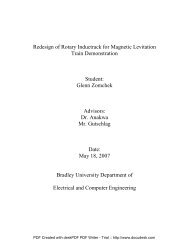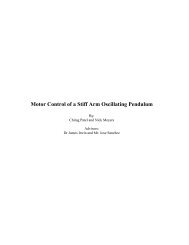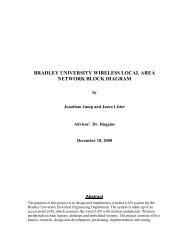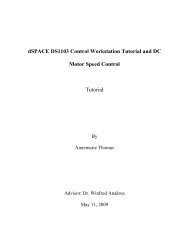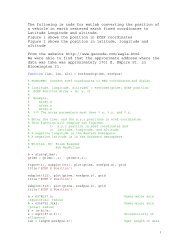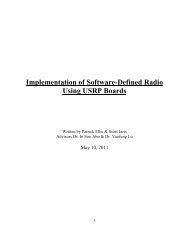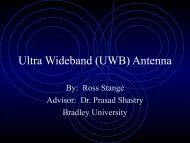Project Proposal - Bradley University ECE department
Project Proposal - Bradley University ECE department
Project Proposal - Bradley University ECE department
Create successful ePaper yourself
Turn your PDF publications into a flip-book with our unique Google optimized e-Paper software.
Automated Industrial Wind Tunnel<br />
Network Control with LabView<br />
Senior <strong>Project</strong> <strong>Proposal</strong><br />
Matt Draear<br />
Advisor: Alexander Malinowski<br />
November 15, 2012
<strong>Project</strong> Summary<br />
The purpose of this project is to upgrade the controls on the Mechanical Engineering<br />
Department’s wind tunnel. The end goal is to create an easy to use user interface that<br />
will allow for both manual control of the wind tunnel and for executing predefined tests<br />
in the form of control sequences for the wind tunnel. In addition, the project will include<br />
the ability for remote operation of the wind tunnel for educational use such as in high<br />
schools. In order to make the system more robust, new National Instruments (NI)<br />
hardware will be installed. The new NI hardware will streamline the user input LabView<br />
control application with the new NI controller running LabView code.<br />
Detailed Description<br />
The Mechanical Engineering <strong>department</strong> would like to make measurements in their<br />
tunnel while using automated test sequences and to update their wind tunnel with a<br />
remote monitoring option for potential remote learning activity. In the past three years,<br />
three senior projects have made progress towards this end. The major missing<br />
component of these projects has been reliable components for the industrial environment.<br />
The block diagram in figure 1 shows the overview block diagram of the entire project<br />
that will be used to add this reliability. <strong>Bradley</strong> <strong>University</strong> students and professors will<br />
be able to control the wind tunnel through a LabView application with advanced direct<br />
control features and with automated test capabilities. Data from wind tunnel tests will be<br />
available in real time and through spreadsheets written with the test data. Drag force, lift<br />
force, pressure in the wind tunnel, pressure outside the wind tunnel, temperature in the<br />
wind tunnel, and temperature outside the wind tunnel will all be measured. A second<br />
application with simplified direct controls will allow high schools to run the wind tunnel<br />
from a remote location over an internet connection. Authentication will be required<br />
before either application is given control of the wind tunnel. Communication from the<br />
control applications will be sent over the Internet and through a network address<br />
translation router to the NI hardware. The NI hardware will have sole control over the<br />
operations of the wind tunnel when enabled. In case of extended connection loss with the<br />
control application the NI hardware will automatically safely shutdown the wind tunnel.<br />
In addition, if power is lost during a test the wind tunnel will shutdown and remain<br />
shutdown. Cameras will also be connected to the network so that wind tunnel tests can<br />
be observed remotely. Three linear actuators will be used to adjust the object in the wind<br />
tunnel during a test.
Computer<br />
Remote<br />
LabView<br />
Operator<br />
Interface<br />
Internet<br />
Router<br />
Ethernet<br />
Ethernet<br />
National Instruments cRio<br />
Real<br />
Time<br />
Cont.<br />
FPGA<br />
Webcams<br />
NI 9472<br />
NI 9205<br />
NI 9211<br />
NI 9505<br />
NI 9505<br />
NI 9505<br />
Fig. 1 - System Block Diagram<br />
Wind Tunnel<br />
Relay Fan On/Off<br />
Relay Damper Direction<br />
Relay Damper On/Off<br />
Actuator #1 Feedback<br />
Actuator #2 Feedback<br />
Actuator #3 Feedback<br />
Wind Tunnel Air Pressure<br />
Ambient Air Pressure<br />
Drag Force<br />
Lift Force<br />
Future Thermocouple #1<br />
Future Thermocouple #2<br />
Actuator #1 Motor<br />
Actuator #2 Motor<br />
Actuator #3 Motor<br />
Computer Remote LabView Operator Interface<br />
The remote LabView operator interface computer in figure 1 is the computer that will be<br />
running the LabView client application that connects to the controlling hardware over the<br />
internet. This computer will function as the user interface to control the wind tunnel.<br />
Router<br />
The router in figure 1 will act as the connection point from the internet to the cameras<br />
and the hardware that controls the wind tunnel.<br />
Webcams<br />
The webcam block in figure 1 consists of three webcams situated around the wind tunnel<br />
system. These will be placed to allow the operator to see how the part being tested is<br />
performing in the wind tunnel. They will also allow the operator to see the status of the<br />
surrounding area of the wind tunnel. The webcam handling will be modular such that<br />
more webcams can be added to the system.<br />
Wind Tunnel<br />
The wind tunnel block in figure 1 consists of a large blower turbine attached to a damper<br />
which then leads to the testing chamber. This damper can be opened or closed to adjust<br />
the speed of the air owing through the system. The wind tunnel also has a platform where<br />
the piece being tested sits. This platform has a linear actuator which can angle the test<br />
part up and down. Connected to this platform are two pressure sensors which are used to<br />
measure the lift and drag forces on the test part. There is also a fog machine attached to<br />
the wind tunnel which is used to visualize the flow of air over an airfoil.<br />
National Instruments cRIO<br />
The National Instruments cRIO in figures 1 and 2 is an expandable industrial controller.<br />
The cRIO includes an FPGA and real time controller. This combination allows for high
speed IO capability with the FPGA as well as real-time controller functionality that can<br />
both be programmed using LabView. The real time controller in the cRIO will be used<br />
to host the LabView web server as well as running control loops. The FPGA in the cRIO<br />
will be used as an interface between the real-time controller and the IO to allow for high<br />
speed IO control that may be desired in the future. The cRIO also offers many IO card<br />
options for interfacing directly to hardware without the need to add additional<br />
conditioning electronics. Figure 2 shows the cRIO with the cards installed that will be<br />
used for the project.<br />
Fig. 2 - National Instruments cRIO<br />
Analog Input NI - 9205<br />
ADC <strong>Project</strong> Requirements<br />
(Minimum 10-bit ADC Resolution)<br />
• Wind tunnel pressure sensor (0-5V)<br />
• Ambient pressure sensor (0-5V)<br />
• Actuator one position feedback (0-5V)<br />
• Actuator two position feedback (0-5V)<br />
• Actuator three position feedback (0-5V)<br />
• Lift force sensor (0-1V)<br />
• Drag force sensor (0-1V)<br />
National Instruments 9205 Quick Hardware Specifications<br />
• 32 single-ended or 16 differential analog inputs<br />
• 16-bit resolution; 250 kS/s aggregate sampling rate<br />
• ±200 mV, ±1, ±5, and ±10 V programmable input ranges<br />
• Overvoltage protection; isolation; NIST-traceable calibration<br />
Thermocouple Input NI - 9211<br />
Temperature <strong>Project</strong> Requirements<br />
• Support for two future thermocouples<br />
National Instruments 9211 Quick Hardware Specifications<br />
• 4 thermocouple or ±80 mV analog inputs<br />
• 24-bit resolution; 50/60 Hz noise rejection<br />
• Works over temperature ranges defined by NIST(J, K, T, E, N, B, R, S<br />
thermocouple types)
Digital Output NI - 9472<br />
Digital Output <strong>Project</strong> Requirements (Transition time < 1s, 5-24V, 7mA)<br />
• Solid state relay for fan on/off control<br />
• Solid state relay for damper on/off control<br />
• Solid state relay for damper direction control<br />
National Instruments 9472 Quick Hardware Specifications<br />
• 8-channel, 100 µs digital output<br />
• 6 to 30 V range, sourcing digital output<br />
• Extreme industrial certifications/ratings<br />
Motor Controller NI - 9505<br />
Motor Controller <strong>Project</strong> Requirements<br />
• Control FA-PO-150-12-4 linear actuator<br />
• Bi-directional control<br />
• Operating current 3 amps<br />
• Inrush current 7 amps<br />
National Instruments 9211 Hardware Specifications<br />
• Continuous current of up to 5 amps at 40 °C<br />
• Full H-bridge brushed servo motor drive with a built-in current sensor<br />
• Peak current 12 amps < 2 seconds max<br />
• Direct connectivity to actuators - fractional horsepower brushed DC servo<br />
motors, relays, lamps<br />
Previous Work<br />
Michael Firman and Benjamin Morisson Web Based Wind Tunnel Control System 2010<br />
• System analysis<br />
• Solid state relays to isolate control of damper and fan motors from control system<br />
• Microcontroller and h-bridge design to control linear actuators<br />
Adam Green Wind Tunnel Control (Remote Control and Measurement of Wind Tunnel<br />
System) 2011<br />
• Network access to controls and measurements<br />
• Use LabView on local PC to control wind tunnel<br />
• Redesigned H-bridge interface with actuator(s) so that the attack angle of the<br />
object can be changed<br />
Daniel Monahan and Nicholas DeTrempe Automated Industrial Wind Tunnel 2012<br />
• Replace National Instruments analog to digital converter with microcontroller<br />
• Work on LabView user interface<br />
Matt Draear LabView Programming Experience<br />
• LabView test equipment programming for Morton Automatic Electric 2012<br />
• FIRST Robotics mentor - LabView programming 2011-2012<br />
Preliminary Work<br />
• Collected product requirements from customer<br />
• Derived wind tunnel I/O control specifications from past project documentation
Task<br />
• Researched available LabView hardware for an affordable solution that would<br />
best interface as the wind tunnel controller<br />
• Contacted National Instruments about the best way to host a LabView server<br />
• Finalized functionality and hardware parts list by discussing it with the customer<br />
Schedule<br />
Week<br />
Number<br />
Week<br />
Starting<br />
Create Basic Program<br />
to Test Hardware<br />
Test Individual<br />
Hardware<br />
Components<br />
Program FPGA I/O<br />
Program FPGA<br />
Control Loops<br />
Test FPGA<br />
Programming<br />
Program Real Time<br />
Controller FPGA<br />
Interface<br />
Program Real Time<br />
Controller Test<br />
Sequence<br />
Program Real Time<br />
Controller Web<br />
Server<br />
Test FPGA with Real<br />
Time Controller<br />
Program Client User<br />
Interface<br />
Test All Software<br />
Together<br />
Connect Hardware<br />
Test Complete<br />
System<br />
Write Final <strong>Project</strong><br />
Paper<br />
Preparation for Oral<br />
Presentation<br />
1 2 3 4 5 6 7 Break 8 9 10 11 12 13 14<br />
1/27 2/3 2/10 2/17 2/24 3/3 3/10 3/17 3/24 3/31 4/7 4/14 4/21 4/28 5/5<br />
Bibliography<br />
[1] Ben Morrison and Mike Firman. “Web Enabled Wind Tunnel System”, Senior<br />
<strong>Project</strong>, Electrical and Computer Engineering Department, <strong>Bradley</strong> <strong>University</strong>, March<br />
2010, http://cegt201.bradley.edu/projects/proj2010/webwind/
[2] Nick Detrempe and Daniel Monahan. “Automated Industrial Wind Tunnel<br />
Controller”, Senior <strong>Project</strong>, Electrical and Computer Engineering Department, <strong>Bradley</strong><br />
<strong>University</strong>, April 2012, http://cegt201.bradley.edu/projects/proj2012/aiwt/<br />
[3] NI CompactRIO, National Instruments, [Online] 2012, http://www.ni.com/compactrio<br />
Equipment List<br />
• NI cRIO - 9074<br />
• Analog Input Card NI-9205<br />
• Thermocouple Input Card NI-9211<br />
• Digital Input Card NI-9472<br />
• Three Motor Controller Cards NI-9505<br />
• Local PC with LabVIEW software - (Real Time and FPGA Modules)<br />
• Wind Tunnel System and Peripheral Components


